The most tourist visiting places in Daily
1.Pura Tanah Lot
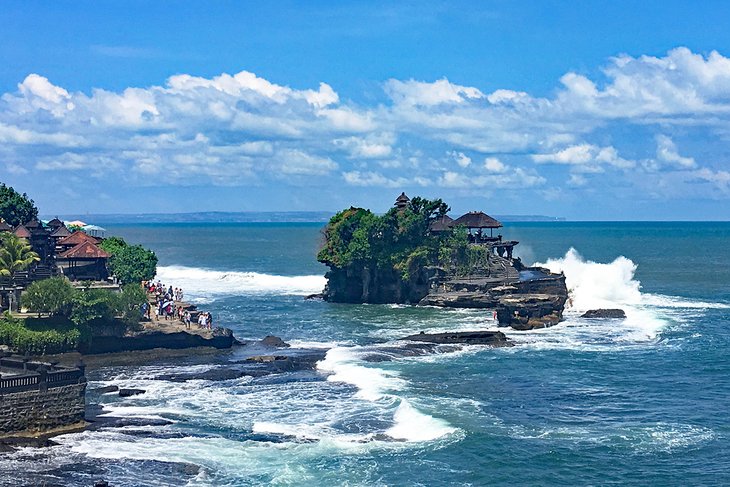
About 20 kilometers northwest of Kuta, Pura Tanah Lot ("Pura" means temple in Balinese) is one of Bali's most iconic temples. Its spectacular seaside setting, on a rocky islet surrounded by crashing waves wows all who visit.
For the Balinese people, it is one of the most sacred of all the island's sea temples. (The largest and holiest Hindu temple in Bali is Pura Besakih, but recently local hagglers have been harassing visitors.) Every evening, throngs of tourists from Kuta, Legian, and Sanur find their way through a labyrinth of lanes lined by souvenir sellers to watch the sun setting behind the temple.
Pura Tanah Lot was built at the beginning of the 16th century and is thought to be inspired by the priest Nirartha, who asked local fishermen to build a temple here after spending the night on the rock outcrop.
Although foreigners can't enter any of the temples, you can walk across to the main temple at low tide, and it's fun to wander along the paths taking photos and soaking up the magnificent setting.
After viewing the various temples and shrines, save time to relax at one of the clifftop restaurants and cafés here and sample the famous Kopi luwak (civet coffee). In some of the cafés, friendly civets snooze on the tables, offering fun Instagram-worthy photo ops.
From Tanah Lot, you can stroll along tropically landscaped pathways to beautiful Batu Bolong, another sea temple perched on a rock outcrop with an eroded causeway connecting it to the shore.
When visiting any temples in Bali, be sure to dress respectfully, and wear a sarong and sash.
2.Uluwatu Temple
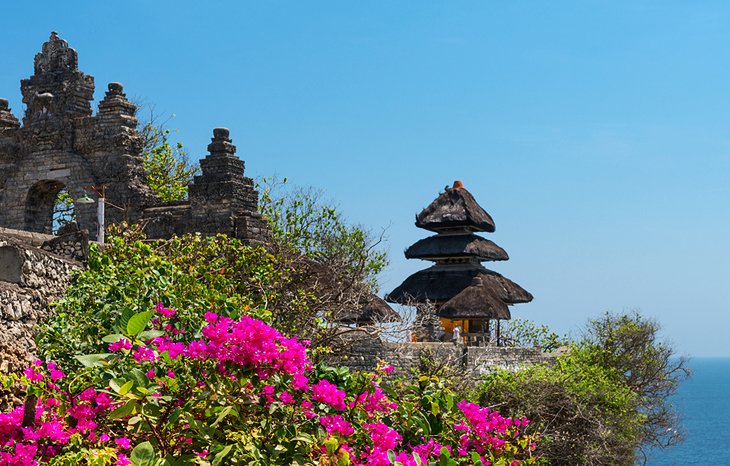
Presiding over plunging sea cliffs above one of Bali's best surf spots, Uluwatu Temple (Pura Luhur Uluwatu) is one of the island's most famous temples, thanks to its magnificent clifftop setting.
In Balinese, "Ulu" means "tip" or "land's end" and "Watu" means rock, a fitting name for the location of the temple on the Bukit Peninsula, along the island's southwestern tip. Like Pura Tanah Lot, sunset is the best time to visit, when the sky and sea glow in the late afternoon light.
Archaeological finds here suggest the temple to be of megalithic origin, dating from around the 10th century. The temple is believed to protect Bali from evil sea spirits, while the monkeys who dwell in the forest near its entrance are thought to guard the temple from bad influences (keep your belongings securely stashed away from their nimble fingers).
A scenic pathway snakes from the entrance to the temple with breathtaking viewpoints along the way. Only Hindu worshippers are allowed to enter the temple, but the beautiful setting and the sunset Kecak dance performances that take place here daily are more than worth the visit.
The temple lies about 25 kilometers from Kuta.
3.Mount Batur
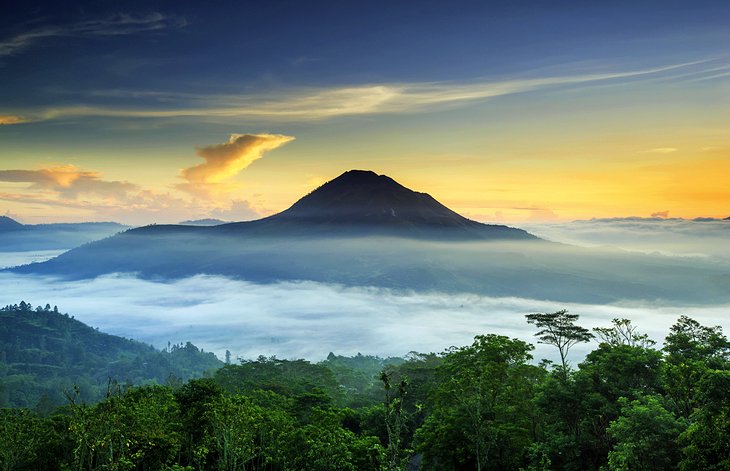
Every day in Bali's predawn darkness, hundreds of visitors begin the trek up the 1,700-meter summit of Mount Batur to watch the sun rise above the lush mosaic of mist-shrouded mountains and the caldera far below.
This sacred active volcano lies in Kintamani District in Bali's central highlands, about an hour's drive from Ubud, and the trek to the summit to watch the sunrise has long graced the list of top things to do in Bali.
The hike, along well-marked trails, is relatively easy and usually takes about two to three hours. Guided treks typically include a picnic breakfast, with eggs cooked by the steam from the active volcano. On a clear day, the views are spectacular, stretching all the way across the Batur caldera; the surrounding mountain range; and beautiful Lake Batur, the island's main source of irrigation water.
Sturdy hiking shoes are essential, and it's advisable to wear layers, as the temperature can be cool before sunrise.
You can also combine a trip here with a visit to one of Bali's most important temples, Pura Ulun Danu Batur, on the lake's northwest shore, and a therapeutic soak in hot springs at the beautiful village of Toya Bungkah on the banks of Lake Batur.
4.Ubud Monkey Forest
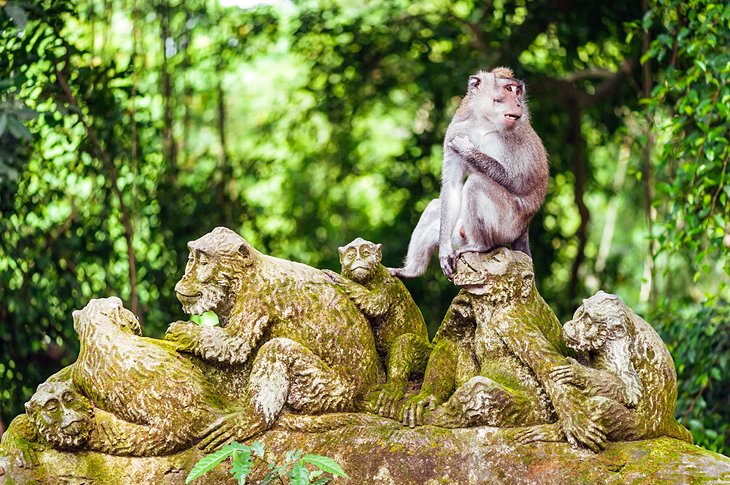
Only 10 minutes' walk south of the town center in Ubud, Bali, the Monkey Forest, also known as the Sacred Monkey Forest Sanctuary, is one of the top things to do in Ubud. It's also one of the best places to visit in Bali if you're an animal lover or photographer.
Besides the entertaining troops of grey long-tailed macaques that make their home here, a large part of the appeal is the evocative jungle setting where the monkeys roam free. Paved pathways lead through thick forests of giant banyan and nutmeg trees, where moss-covered statues and ancient temples loom through the dense foliage, imparting an almost mystical feel.
The forest is intended to represent the harmonious coexistence between humans and animals. It also conserves rare plants and is used as a location for researching macaque behavior, particularly their social interaction.
On the southwest side of the forest is one of the three temples found here, the 14th-century Pura Dalem Agung Padangtegal, where hundreds of monkeys swing through the trees and clamber over the walls.
In the northwest of the forest, an ancient bathing temple, Pura Beji, nestles next to a cool stream and makes a beautiful backdrop for watching the monkeys' antics.
While visiting the forest, make sure to secure your belongings and avoid direct eye contact with the animals (and smiling), as this can be interpreted as a sign of aggression. It's also a good idea not to bring any food into the area.
Address: Jalan Monkey Forest, Padangtegal, Ubud, Gianyar, Bali
5. Ubud Art & Culture
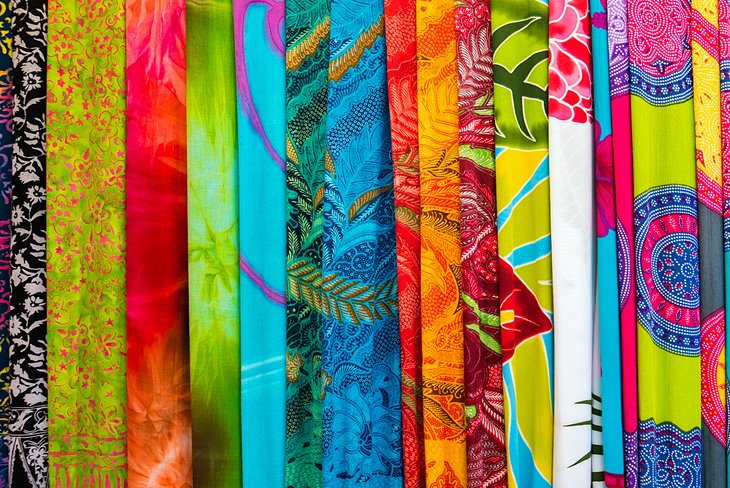
Made famous by the book and movie Eat, Pray, Love, Ubud is also the epicenter of Balinese art and culture. This is where the modern Balinese art movement was born, with the surrounding royal palaces and temples acting as the main patrons.
Today, several excellent local museums and galleries celebrate its evolution and traditions. Art gazing is particularly rewarding here, as many collections are housed in traditional Balinese buildings surrounded by serene tropical gardens.
For an overview of Balinese art, your first stops should be Agung Rai Museum of Art (ARMA) and the Neka Art Museum, which lie within a short stroll of the Ubud Monkey Forest. Collections at both include works ranging from traditional to contemporary, including kris (ceremonial daggers), photography, and classical wayang (puppet-figure) paintings.
Other art galleries and museums in the Ubud area that might be of interest to art lovers include Setia Darma House of Masks & Puppets featuring ceremonial masks from Asia and beyond; Museum Puri Lukisan, spanning a range of Balinese artistic styles; and the Don Antonio Blanco Museum, at the artist's former home and studio.
If shopping for art is more your style, don't miss the Ubud Art Market. This labyrinth of stalls brims with carvings, sculptures, jewelry, sarongs, paintings, and homewares and is one of the top tourist attractions in town. Bargaining is essential, and a good rule of thumb is to counter with half the asking price and barter upwards from there, always with a smile.
Opposite the market, the Puri Saren Royal Ubud Palace is also worth a visit. Attending a traditional Balinese dance performance during the evening here is one of the top things to do in Bali at night — especially for families.
If you're a budding artist or have children in tow, you can sign up for an art workshop at a local village, which can include traditional painting, mask-making, and jewelry making
6.Pura(temple) Ulun Danu Bratan
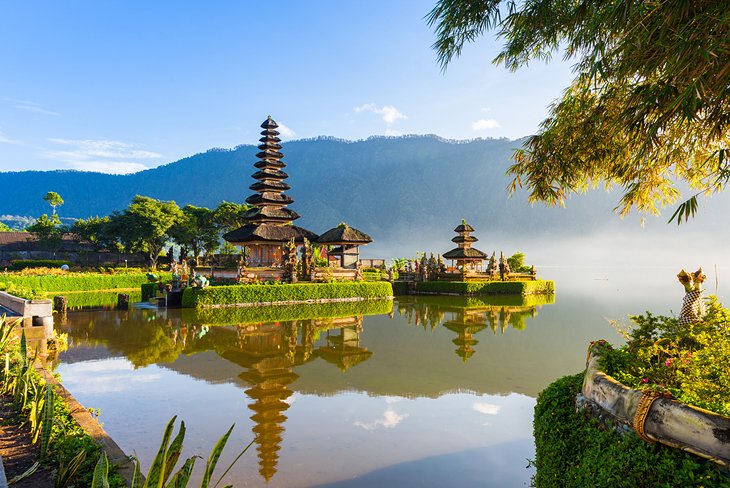
On a small island along the western shore of Lake Bratan, in the cool highlands of central Bali, the 17th-century Pura Ulun Danu Bratan is one of Bali's most picturesque temple complexes. Set against the imposing backdrop of Gunung Bratan, the thatched temples reflect on the lake, and when the water levels rise, they seem to float on its surface.
Lake Bratan is one of Bali's main sources of irrigation and drinking water, and the temple complex is dedicated to Dewi Danu, goddess of the sea and lakes.
An unusual feature is the Buddhist stupa on the left of the entrance to the first courtyard, with figures of Buddha meditating in the lotus position in niches on the square base. The stupa reflects the adoption of Buddhist beliefs by Balinese Hindus.
This sacred Hindu temple complex is best seen in the soft morning light, before the tourist buses arrive, when cool mist sometimes cloaks the lake and the mountains beyond. You can also hire a canoe and paddle out on the lake to explore the meru (thatched shrines) at close range.
Not far from the temple complex, the Bali Botanic Garden (Kebun Raya Bali) is also worth a visit, with its beautiful bamboo forests, begonias, orchid collection, and medicinal plants. Within its grounds, the Bali Treetop Adventure Park is fun for kids, with ziplines, Tarzan swings, and suspension bridges.
7.Tegallalang and Jatiluwih Rice Terraces in Bali
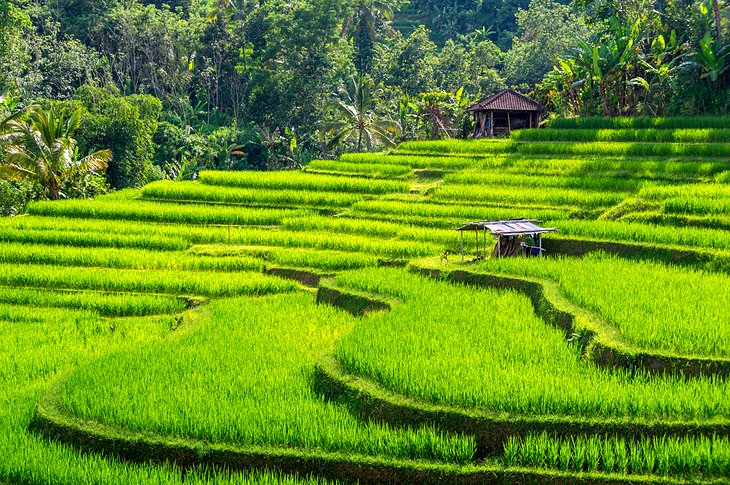
If you're a photographer seeking to capture Bali's beautiful emerald-hued rice fields, the Tegallalang or Jatiluwih rice terraces should be at the top of your sightseeing agenda.
About a 30-minute drive north of Ubud, Tegallalang Rice Terraces are one of the most famous areas to photograph these iconic landscapes and absorb their timeless beauty. Be aware that locals ask for donations along the most popular trail through the rice fields here, and many request fees for entrance and parking along the road. A relaxing way to enjoy the lush landscapes is at one of the many restaurants and cafés overlooking the fields.
About a 90-minute drive from Ubud, the Jatiluwih rice terraces cover more than 600 hectares of rice fields along the hillsides of the Batukaru mountain range and tend to be less crowded than Tegallalang. You'll also find fewer tourist touts here, so it's easier to walk around and explore without being hassled.
Both of these locations use the traditional water management cooperative called "subak," a UNESCO-recognized irrigation system that dates to the 9th century.
8.Tirta Empul Temple
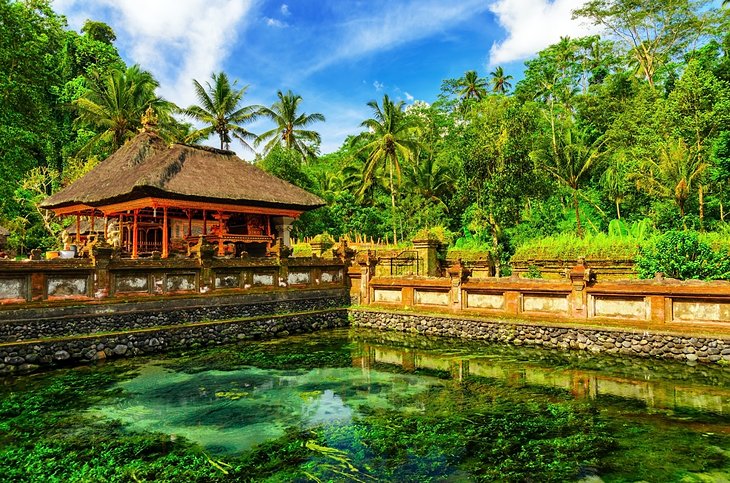
Dating from around AD 960, Tirta Empul Temple (Pura Tirta Empul) in the lush tropical forest of Central Bali, offers a glimpse into a sacred purification ritual.
This important temple complex, a national cultural heritage site, is divided into three courtyards. The focal point is the large, rectangular pool, fed by a holy mountain spring, where locals come to pray and soak in the healing waters that gush from a series of sculpted spouts.
If you wish to join the locals in the cleansing ritual, it's best to ask an experienced guide first to make sure you respect the customs. You must enter the water fully clothed, wearing a sarong and sash, and it's best to explore the temple complex first, as you are not allowed to drip water in the courtyards.
To avoid the tourist buses, early morning and late afternoon are the best times to visit the temple.
9.Mount And Lake Batur - Magnificent Views
Also known as Kintamani volcano, Mount Batur is one of the most dramatic landscape for sightseeing in Bali. With the magnificent view of its a 13 sq km caldera and a beautiful lake which fills the large part of the caldera, it offers a fantastic spectacle to a visitor.
Things to do: Visit Pura Ulun Danu Batur; linger around the craters on the mountain; swim in the hot springs; ride a bike through the ancient villages
Cant miss: Trek to the peak before sunrise, soak yourself in the beautiful sunrise and have a breakfast of the eggs boiled in the volcano














No comments:
Post a Comment